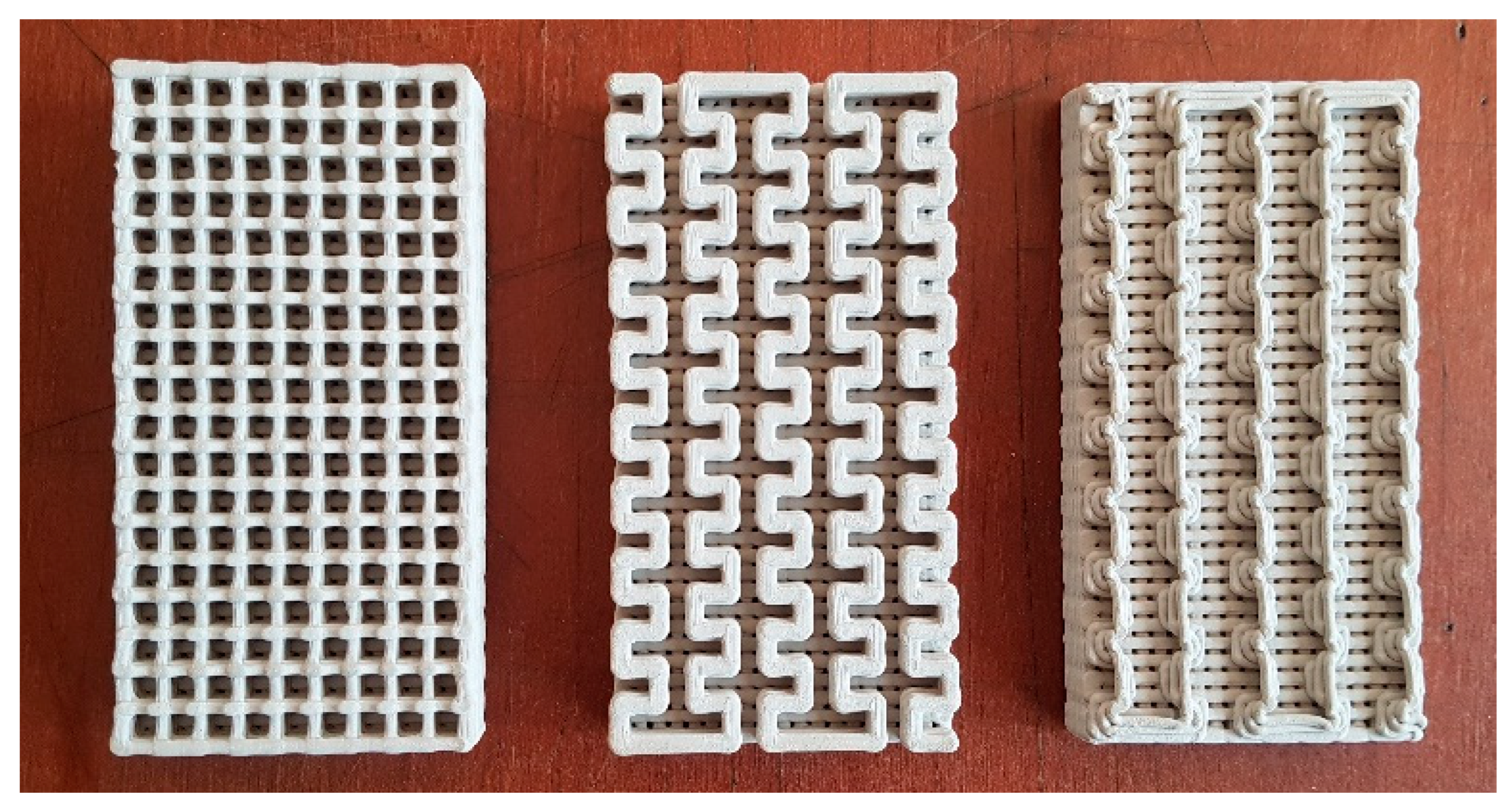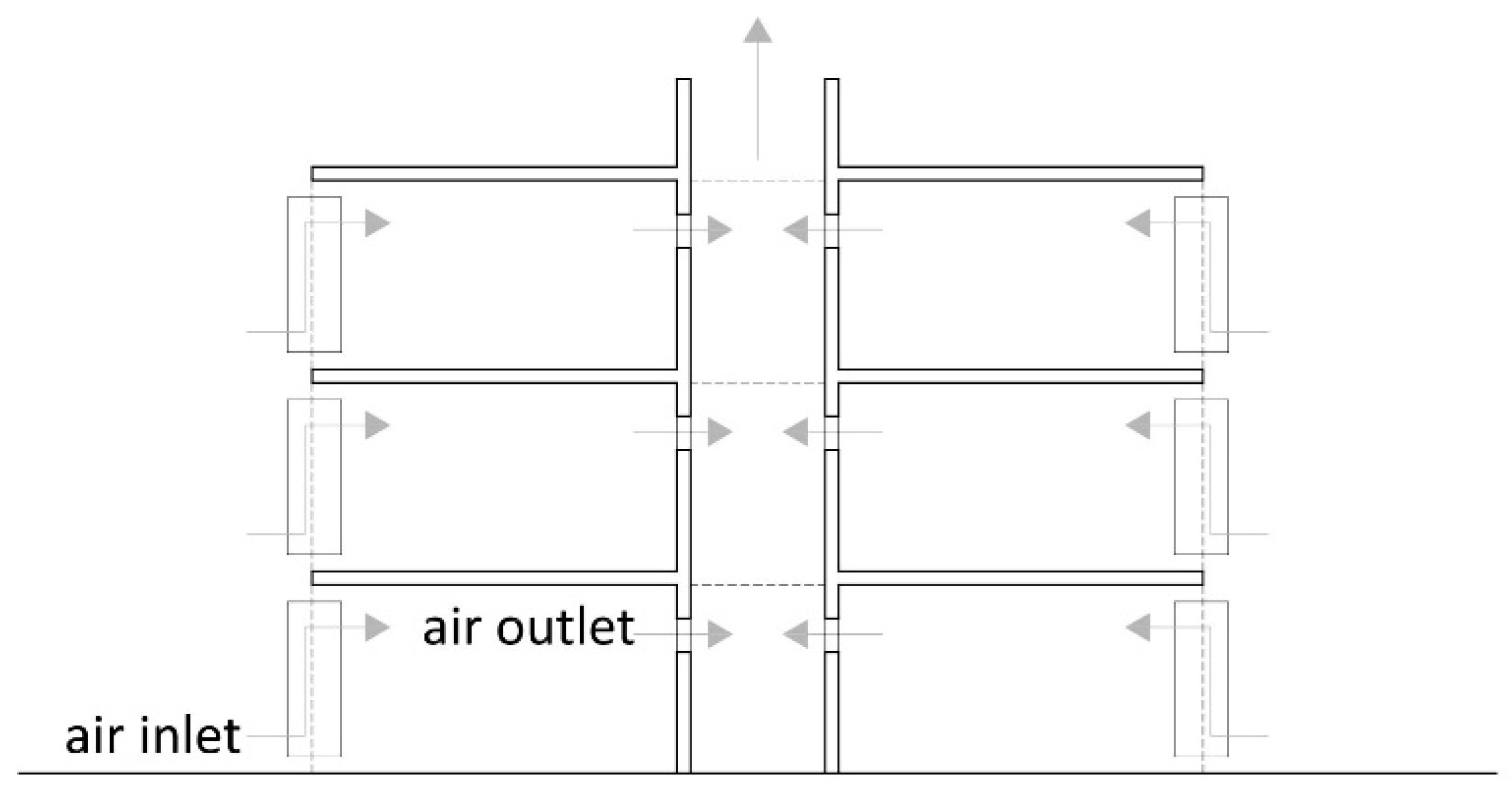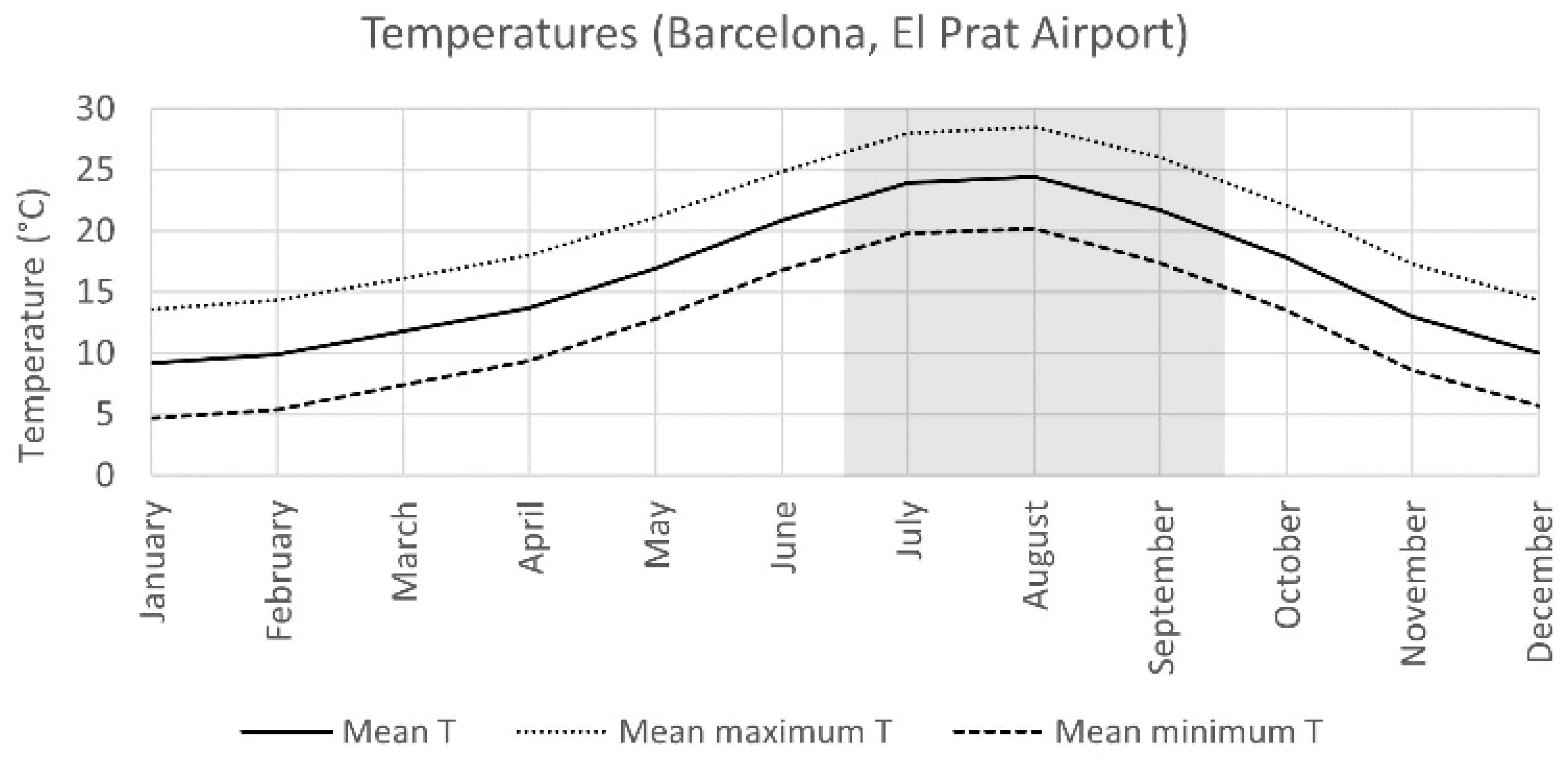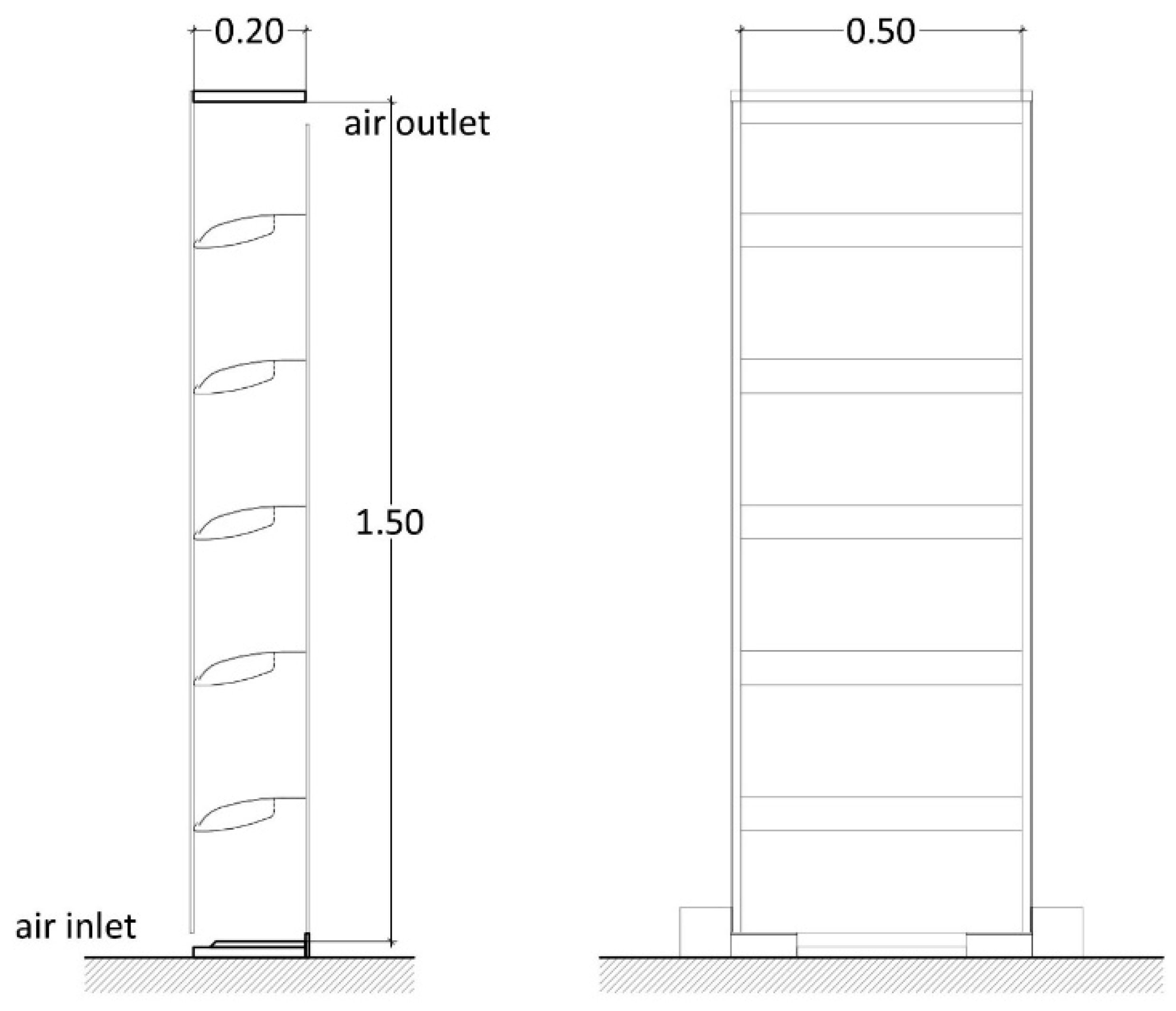Exploring the Integration of a Novel Photocatalytic Air Purification Façade Component in Buildings
Abstract
1. Introduction
2. Component Description
2.1. Technological Context
2.2. The Panel
2.3. The Slat
3. Component Functionality Tests
3.1. Building Ventilation
3.2. Air Purification
3.3. Solar Protection
3.4. Thermal Behaviour
4. Conclusions
5. Patents
Author Contributions
Funding
Data Availability Statement
Acknowledgments
Conflicts of Interest
References
- OHCHR. The Right to Adequate Housing; Fact Sheet No. 21/Rev. 1; Office of the United Nations High Commissioner for Human Rights: Geneva, Switzerland, 2014; Available online: https://unhabitat.org/sites/default/files/download-manager-files/Right%20to%20adequate%20housing.pdf (accessed on 28 October 2021).
- COAC. Espais Interiors Saludables; Col·legi Oficial d’Arquitectes de Catalunya: Barcelona, Spain, 2020; Available online: www.arquitectes.cat/ca/guia-espais-saludables (accessed on 28 October 2021).
- ILFI. Health & Happiness Petal Intent: Living Building Challenge; International Living Future Institute: Seattle, WA, USA, 2021; Available online: https://www.manula.com/manuals/living-future/living-building-challenge-4-1/1/en/topic/i10-intent-requirements (accessed on 28 October 2021).
- Ortiz, M.; Itard, L.; Bluyssen, P.M. Indoor environmental quality related risk factors with energy-efficient retrofitting of housing: A literature review. Energy Build. 2020, 221, 110102. [Google Scholar] [CrossRef]
- Burge, S.; Hedge, A.; Wilson, S.; Bass, J.H.; Robertson, A. Sick building syndrome: A study of 4373 office workers. Ann. Occup. Hyg. 1987, 31, 493–504. [Google Scholar] [CrossRef] [PubMed]
- Rostron, J. Sick building syndrome: A review of causes, consequences and remedies. J. Retail Leis. Prop. 2008, 7, 291–303. [Google Scholar] [CrossRef]
- Jaakkola, J.J.K.; Miettinen, P. Type of Ventilation System in Office Buildings and Sick Building Syndrome. Am. J. Epidemiol. 1995, 141, 755–765. [Google Scholar] [CrossRef] [PubMed]
- Luna-Navarro, A.; Loonen, R.; Juaristi, M.; Monge-Barrio, A.; Attia, S.; Overend, M. Occupant-Facade interaction: A review and classification scheme. Build. Environ. 2020, 177, 106880. [Google Scholar] [CrossRef]
- WHO. Public Health and Environment; World Health Organisation: Geneva, Switzerland, 2021; Available online: https://www.who.int/data/gho/data/themes/public-health-and-environment (accessed on 28 October 2021).
- WHO. Ambient (Outdoor) Air Pollution; World Health Organisation: Geneva, Switzerland, 2021; Available online: https://www.who.int/en/news-room/fact-sheets/detail/ambient-(outdoor)-air-quality-and-health (accessed on 28 October 2021).
- EEA. Air Quality in Europe: 2019 Report; European Environment Agency: Copenhagen, Denmark, 2019. [CrossRef]
- CEN. Guideline for Using Indoor Environmental Input Parameters for the Design and Assessment of Energy Performance of Buildings; CEN TC 156. WG 19-N89. Draft 8 EN/TR 16798-2 WD; Comité Européen de Normalisation: Brussels, Belgium, 2002. [Google Scholar]
- Brager, G.S.; Paliaga, G.; de Dear, R. Operable Windows, Personal Control, and Occupant Comfort. ASHRAE Trans. 2004, 110, 17–35. Available online: https://escholarship.org/uc/item/4x57v1pf (accessed on 5 August 2024).
- Luo, M.; Cao, B.; Ji, W.; Ouyang, Q.; Lin, B.; Zhu, Y. The Underlying Linkage between Personal Control and Thermal Comfort: Psychological or Physical Effects? Energy Build. 2016, 111, 56–63. [Google Scholar] [CrossRef]
- Santamouris, M.; Wouters, P. (Eds.) Building Ventilation: The State of the Art; Earthscan: London, UK, 2006. [Google Scholar]
- GhaffarianHoseini, A.; Berardi, U.; Tookey, J.; Li, D.H.W.; Kariminia, S. Exploring the advantages and challenges of double-skin facądes (DSFs). Renew. Sustain. Energy Rev. 2016, 60, 1052–1065. [Google Scholar] [CrossRef]
- Pomponi, F.; Piroozfar, P.A.E.; Southall, R.; Ashton, P.; Farr, E.R.P. Energy performance of Double-Skin Façades in temperate climates: A systematic review and meta-analysis. Renew. Sustain. Energy Rev. 2016, 54, 1525–1536. [Google Scholar] [CrossRef]
- Barbosa, S.; Ip, K. Perspectives of double skin façades for naturally ventilated buildings: A review. Renew. Sustain. Energy Rev. 2014, 40, 1019–1029. [Google Scholar] [CrossRef]
- Peng, J.; Curcija, D.C.; Lu, L.; Selkowitz, S.E.; Yang, H.; Zhang, W. Numerical investigation of the energy saving potential of a semi-transparent photovoltaic double-skin façade in a cool-summer Mediterranean climate. Appl. Energy 2016, 165, 345–356. [Google Scholar] [CrossRef]
- Lee, C.-S.; Lee, H.; Choi, M.; Yoon, J. Design optimization and experimental evaluation of photovoltaic double skin façade. Energy Build. 2019, 202, 109314. [Google Scholar] [CrossRef]
- Eom, Y.S.; Kang, D.H.; Choi, D.H. Numerical analysis of PM2.5 particle collection efficiency on an electrostatic precipitator integrated with double skin façade in a residential home. Build. Environ. 2019, 162, 106245. [Google Scholar] [CrossRef]
- Stec, W.J.; van Paassen, A.H.C.; Maziarz, A. Modelling the double skin façade with plants. Energy Build. 2005, 37, 419–427. [Google Scholar] [CrossRef]
- Flores Lazo, J. Integración en Fachada de Mecanismos de Depuración de Aire. Master’s Thesis, Polytechnic University of Catalonia, Barcelona, Spain, 2019, (unpublished). [Google Scholar]
- Knaack, U.; Klein, T.; Bilow, M.; Auer, T. Façades: Principles of Construction, 2nd ed.; Birkhäuser: Boston, MA, USA, 2014. [Google Scholar]
- Prieto, A.; Klein, T.; Knaack, U.; Auer, T. Main perceived barriers for the development of building service integrated facades: Results from an exploratory expert survey. J. Build. Eng. 2017, 13, 96–106. [Google Scholar] [CrossRef]
- Panitz, T.; Wasan, D.T. Flow attachment to solid surfaces: The Coanda effect. AIChE J. 1972, 18, 51–57. [Google Scholar] [CrossRef]
- Aguilar, P.; Borunda, L.; Pardal, C. Additive manufacturing of variable-density ceramics, photocatalytic and filtering slats. In Anthropologic: Architecture and Fabrication in the Cognitive Age, Proceedings of the 38th eCAADe Conference, Berlin, Germany, 16–17 September 2020; Technical University of Berlin: Berlin, Germany, 2020; Volume 1, pp. 97–106. Available online: https://cumincad.scix.net/cgi-bin/works/Show?ecaade2020_484 (accessed on 29 October 2021).
- Aguilar, P. Impresión 3D Cerámica de Densidad Variable Controlada. Ph.D. Dissertation, UPC, Architectural Technology Department, Barcelona, Spain, 2024. [Google Scholar] [CrossRef]
- Allard, F.; Santamouris, M. (Eds.) Natural Ventilation in Buildings: A Design Handbook; James & James: London, UK, 1998. [Google Scholar]
- ISO 17772-1:2017; Energy Performance of Buildings—Indoor Environmental Quality. Part 1: Indoor Environmental Input Parameters for the Design and Assessment of Energy Performance of Buildings. International Organization for Standardization: Geneva, Switzerland, 2017.
- ISO/TR 17772-2:2018; Energy Performance of Buildings—Overall Energy Performance Assessment Procedures. Part 2: Guideline for Using Indoor Environmental Input Parameters for the Design and Assessment of Energy Performance of Buildings. International Organization for Standardization: Geneva, Switzerland, 2018.
- BS EN 16798-1:2019; Energy Performance of Buildings. Ventilation for Buildings. Part 1: Indoor Environmental Input Parameters for Design and Assessment of Energy Performance of Buildings Addressing Indoor Air Quality, Thermal Environment, Lighting and Acoustics. British Standards Institution: London, UK, 2019.
- CEN/TR 16798-2: 2019; Energy Performance of Buildings. Ventilation for Buildings. Part 2: Interpretation of the Requirements in EN 16798-1—Indoor Environmental Input Parameters for Design and Assessment of Energy Performance of Buildings Addressing Indoor Air Quality. Comité Européen de Normalisation: Brussels, Belgium, 2019.
- ASHRAE Standard 62.1-2016. Ventilation for Acceptable Indoor Air Quality; American Society of Heating, Refrigerating and Air-Conditioning Engineers: Washington, DC, USA, 2016. [Google Scholar]
- ASHRAE Standard 62.2-2010. Ventilation for Acceptable Indoor Quality in Low Rise Residential Buildings; American Society of Heating, Refrigerating and Air-Conditioning Engineers: Washington, DC, USA, 2010. [Google Scholar]
- Khovalyg, D.; Kazanci, O.B.; Halvorsen, H.; Gundlach, I.; Bahnfleth, W.P.; Toftum, J.; Olesen, B.W. Critical review of standards for indoor thermal environment and air quality. Energy Build. 2020, 213, 109819. [Google Scholar] [CrossRef]
- España Ministerio de la Presidencia. Real Decreto 1027/2007, de 20 de julio, por el que se aprueba el Reglamento de instalaciones Térmicas en los Edificios. In Boletín Oficial del Estado; n. 207, 29/08/2007; MPR: Madrid, Spain, 2007; pp. 35931–35984. Available online: https://www.boe.es/boe/dias/2007/08/29/pdfs/A35931-35984.pdf (accessed on 28 October 2021).
- IDAE. Recomendaciones de Operación y Mantenimiento de los Sistemas de Climatización y Ventilación de Edificios y Locales para la Prevención de la Propagación del SARS-CoV-2; Gobierno de España. Ministerio de Sanidad: Madrid, Spain; Ministerio para la Transición Ecológica y el Reto Demográfico: Madrid, Spain; Instituto para la Diversificación y Ahorro de la Energía: Madrid, Spain, 2020; Available online: https://www.mscbs.gob.es/profesionales/saludPublica/ccayes/alertasActual/nCov/documentos/Recomendaciones_de_operacion_y_mantenimiento.pdf (accessed on 28 October 2021).
- Salonen, H.; Salthammer, T.; Morawska, L. Human exposure to NO2 in school and office indoor environments. Environ. Int. 2019, 130, 104887. [Google Scholar] [CrossRef]
- Alberts, W.M. Indoor air pollution: NO, NO2, CO, and CO2. J. Allergy Clin. Immunol. 1994, 94, 289–295. [Google Scholar] [CrossRef] [PubMed]
- Ministerio para la Transición Ecológica y el Reto Demográfico. Mapa de Calidad del Aire. 2024. Available online: https://sig.miteco.gob.es/calidad-aire/ (accessed on 7 August 2024).
- Generalitat de Catalunya. Qualitat de l’aire Actual; Medi Ambient i Sostenibilitat: Barcelona, Spain, 2024; Available online: https://mediambient.gencat.cat/ca/05_ambits_dactuacio/atmosfera/qualitat_de_laire/vols-saber-que-respires/ (accessed on 7 August 2024).
- ISO 16890-1:2016; Air Filters for General Ventilation—Part 1: Technical Specifications, Requirements and Classification System Based Upon Particulate Matter Efficiency (ePM). International Organization for Standardization: Geneva, Switzerland, 2016.
- Kang, K.; Kim, T.; Shin, C.W.; Kim, K.; Kim, J.; Lee, Y.G. Filtration efficiency and ventilation performance of window screen filters. Build. Environ. 2020, 178, 106878. [Google Scholar] [CrossRef]
- Boyjoo, Y.; Sun, H.; Liu, J.; Pareek, V.K.; Wang, S. A review on photocatalysis for air treatment: From catalyst development to reactor design. Chem. Eng. J. 2017, 310, 537–559. [Google Scholar] [CrossRef]
- Maness, P.-C.; Smolinski, S.; Blake, D.M.; Huang, Z.; Wolfrum, E.J.; Jacoby, W.A. Bactericidal activity of photocatalytic TiO2 reaction: Toward an understanding of its killing mechanism. Appl. Environ. Microbiol. 1999, 65, 4094–4098. [Google Scholar] [CrossRef] [PubMed]
- ISO 22197-1; Fine Ceramics (Advanced Ceramics, Advanced Technical Ceramics)—Test Method for Air-Purification Performance of Semiconducting Photocatalytic Materials — Part 1: Removal of Nitric Oxide. International Organization for Standardization: Geneva, Switzerland, 2007.
- Manz, H. Total solar energy transmittance of glass double façades with free convection. Energy Build. 2004, 36, 127–136. [Google Scholar] [CrossRef]
- Shameri, M.A.; Alghoul, M.A.; Sopian, K.; Zain, M.F.M.; Elayeb, O. Perspectives of double skin façade systems in buildings and energy saving. Renew. Sustain. Energy Rev. 2011, 15, 1468–1475. [Google Scholar] [CrossRef]
- Roig, O.; Cuerva, E.; Pardal, C.; Guardo, A.; Isalgue, A.; Lopez-Besora, J. Thermal assessment of ventilated double skin façade component with a set of air filtering photocatalytic slats in the cavity. Buildings 2023, 13, 272. [Google Scholar] [CrossRef]
- Pardal March, C.; Paricio Ansuategui, I.; Aguilar Urquidez, P.; Lopez Besora, J.; Flores Lazo, J.; Roig Mayoral, O. Sistema de Depuración Fotocatalítica. Patent Number P202030141, 27 January 2022. [Google Scholar]
- Pardal March, C.; Lopez Besora, J.; Alonso Montolio, C.; Cuerva Contreras, E.; Guardo Zabaleta, A.; Flores Lazo, J. Dispositivo Para Depuracion de Aire Con Lamas Con Propiedades Fotocataliticas (Modelo de Utilidad). Patent Number ES1248829, 17 September 2020. [Google Scholar]









| PD | Standard | Adaptation | qp Occupation (L/pers) |
|---|---|---|---|
| CAT.II | ISO 17772, EN 16798 [30,31,32] | Adapted | 2.5 |
| Non-adapted | 7 | ||
| ASHRAE 62.1 [34] | Adapted | 2.5 (offices), 3.8 (lecture halls, auditoria), 5 (classrooms age +5) | |
| PD | Standard | Environment | qB Building Component (L/s·pers) |
| CAT.II | ISO 17772, EN 16798 [30,31,32] | Very low polluting | 0.35 |
| Low polluting | 0.7 | ||
| Non-low polluting | 1.4 | ||
| ASHRAE 62.1 [34] | - | 0.3 (offices, auditoria), 0.6 (classrooms age +5) | |
| IDA | Standard | qsu Surface Unit (dm3/s·m2) | qo Occupation (dm3/s·pers) |
| IDA 2 | RITE [37] | 0.83 | 12.5 |
| Occupation Air Flow | Building Component Air Flow | Occupation | Total Air Flow | Air Speed | Dimension of the Gap |
|---|---|---|---|---|---|
| qp (L/s·pers) | qB (L/s·m2) | (m2/pers) | qtot (L/s·m2) | va (m/s) | Sv (cm) |
| 7 | 1.4 | 10 | 2.1 | 0.12 | 1.75 × 100 |
| 2.5 | 0.35 | 10 | 0.6 | 0.12 | 0.5 × 100 |
| 12.5 | - | 10 | 1.25 | 0.12 | 1 × 100 |
| Num. | Code | Support Material | Coating |
|---|---|---|---|
| 1 | AX-PUR | Extruded aluminium | PuretiTM paint |
| 2 | AX-PVC | Extruded aluminium | High-speed thermal projection |
| 3 | AX-CLE | Extruded aluminium | ProCleanTM paint |
| 4 | CI-1C-PUR | Printed ceramic (one-side perforation) | PuretiTM paint |
| 5 | CI-1C-CLE | Printed ceramic (one-side perforation) | ProCleanTM paint |
| 6 | CI-2C-PUR | Printed ceramic (perforation on both sides) | PuretiTM paint |
| 7 | CI-1C-PVC | Printed ceramic (one-side perforation) | High-speed thermal projection |
| 8 | CX-PUR | Extruded ceramic | PuretiTM paint |
| 9 | CX-CLE | Extruded ceramic | ProCleanTM paint |
| 10 | CX-PVC | Extruded ceramic | High-speed thermal projection |
| 11 | AE-M-PUR | Foamed aluminium, medium porosity | PuretiTM paint |
| Operation Conditions |
|---|
| Total flow: 3000 mL/min |
| [NO] = 1000 ppb |
| R.H. = 50% |
| Irradiance UV-A: 10 W/m2 |
| Irradiation time with UV-A light: 300 min |
| Distance between the test tube and reactor window: 0.5 cm |
| Phases of the Study |
| Phase1: bypass air for 30 min |
| Phase 2: air + NO in bypass mode for 30 min |
| Phase 3: air + NO in reactor mode for 30 min |
| Phase 4: air + NO in reactor mode + UV-A for 300 min |
| Phase 5: cleaning with air for 30 min |
| Num. | Code | XNO (%) | XNOX (%) | NOe (μmol) | NOxe (μmol) | NO2 (μmol) |
|---|---|---|---|---|---|---|
| 1 | AX-PUR | 3 | 1 | 1.36 | 0.37 | 1.26 |
| 2 | AX-PVC | 5 | 3 | 1.97 | 1.05 | 0.92 |
| 3 | AX-CLE | 9 | 5 | 3.46 | 2.15 | 1.31 |
| 4 | CI-1C-PUR | - | - | - | - | - |
| 5 | CI-1C-CLE | 3 | 2 | 1.2 | 0.46 | 0.74 |
| 6 | CI-2C-PUR | 3 | 2 | 1.45 | 1.10 | 0.50 |
| 7 | CI-1C-PVC | 5 | 3 | 2.13 | 1.10 | 1.00 |
| 8 | CX-PUR | - | - | - | - | - |
| 9 | CX-CLE | 2 | 1 | 0.90 | 0.68 | - |
| 10 | CX-PVC | 2 | 2 | 0.90 | 0.70 | - |
| 11 | AE-M-PUR | 2 | 2 | 0.8 | 0.67 | 0.10 |
| S (m2) | U (W/m2K) | Q (m3/s) | δ (kg/m3) | Ce (W/°C Kg) | ||
|---|---|---|---|---|---|---|
| Losses | Glass | Sg = 1.50 | Ug = 5 | |||
| Wood | Sw = 0.8 | Uw = 2.54 | ||||
| Air | Qa = 0.002 | δa = 1.21 | Cea = 1006 | |||
| Gains | S (m2) | t | α | Rv (W/m2) | ||
| Glass | Sg = 0.75 | 0.96 | 0.2 | |||
| Sol.rad. | Rv = 600 |
Disclaimer/Publisher’s Note: The statements, opinions and data contained in all publications are solely those of the individual author(s) and contributor(s) and not of MDPI and/or the editor(s). MDPI and/or the editor(s) disclaim responsibility for any injury to people or property resulting from any ideas, methods, instructions or products referred to in the content. |
© 2024 by the authors. Licensee MDPI, Basel, Switzerland. This article is an open access article distributed under the terms and conditions of the Creative Commons Attribution (CC BY) license (https://creativecommons.org/licenses/by/4.0/).
Share and Cite
Lopez-Besora, J.; Pardal, C.; Isalgue, A.; Roig, O. Exploring the Integration of a Novel Photocatalytic Air Purification Façade Component in Buildings. Buildings 2024, 14, 2481. https://doi.org/10.3390/buildings14082481
Lopez-Besora J, Pardal C, Isalgue A, Roig O. Exploring the Integration of a Novel Photocatalytic Air Purification Façade Component in Buildings. Buildings. 2024; 14(8):2481. https://doi.org/10.3390/buildings14082481
Chicago/Turabian StyleLopez-Besora, Judit, Cristina Pardal, Antonio Isalgue, and Oriol Roig. 2024. "Exploring the Integration of a Novel Photocatalytic Air Purification Façade Component in Buildings" Buildings 14, no. 8: 2481. https://doi.org/10.3390/buildings14082481
APA StyleLopez-Besora, J., Pardal, C., Isalgue, A., & Roig, O. (2024). Exploring the Integration of a Novel Photocatalytic Air Purification Façade Component in Buildings. Buildings, 14(8), 2481. https://doi.org/10.3390/buildings14082481







